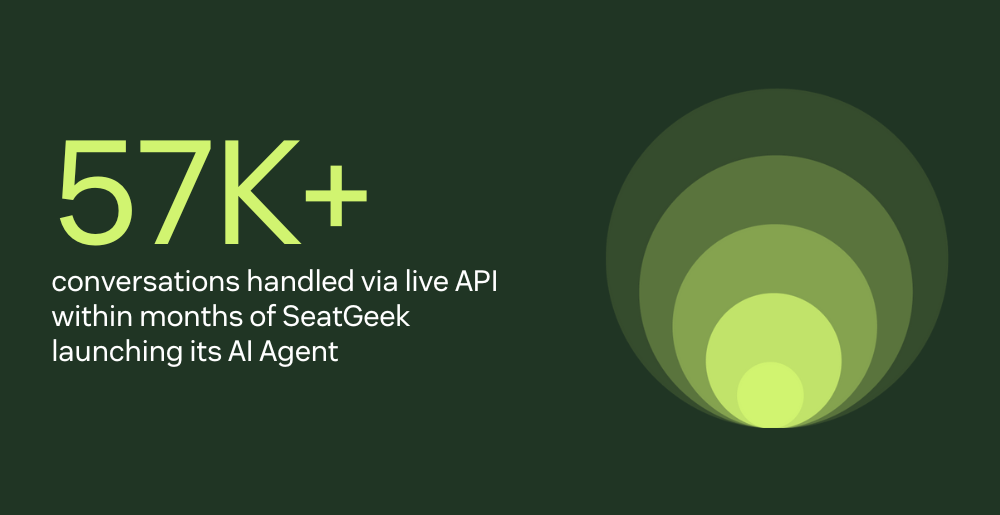4 min read
Results, not hype: How SeatGeek and TransferGo use AI to deliver real CX impact
From faster answers to more personalized experiences, these CX leaders prove that having the right foundation is the key to AI success.
Maggie Mazzetti
Group Manager, Content Marketing
최종 업데이트: August 11, 2025
AI might be the hot topic in CX, but for Whitney Thomas at SeatGeek and Marta Survilo at TransferGo, it’s a core strategy.
During the recent Zendesk AI Masterclass, both leaders pulled back the curtain on how they’ve embedded AI into their service models. The result? Smarter automation, faster resolutions, and experiences that scale without losing the human touch.
“What drives us is the desire to provide excellent customer experience with support that’s not just reactive, but also personalized and proactive.”
– Marta Survilo, VP of Customer Experience and Operations at TransferGo
Read on to learn how both companies built a strong AI foundation and turned it into measurable gains for agents, customers, and their business.
1. Start with your most common pain points
SeatGeek and TransferGo both kicked off their AI journey by targeting the areas of greatest friction for both agents and customers. For SeatGeek, that meant finding a better way to answer their most common customer question: Where are my tickets?
“We started with our most repetitive intent,” said Whitney. She figured that if fans had a way to find their tickets without reaching out to an agent, her team could save time across the board and make the experience way better for everyone involved.

By integrating with backend systems and testing logged-in experiences, SeatGeek was able to do just that by authenticating users, surfacing ticket data in real time, and cutting down on unnecessary escalations.
“We focused on one category first, made sure we really nailed that down, and then quickly broadened that approach to more issue types.”
– Whitney Thomas, Senior Business Systems Analyst at SeatGeek
TransferGo took a similar approach. “We really started with simple, straightforward scenarios, mostly focusing on how-to questions,” said Marta. “Then as we progressed, we empowered our chatbots to provide more in-depth information to the client.”
Eventually, they empowered their chatbots to take direct action on things like refunding orders or checking transfer statuses, all thanks to API integrations with their internal systems.
2. Build agility into your AI strategy
AI evolves fast, which means your strategy should, too. Both companies emphasized the importance of learning while doing and being open to change.
“We were learning on the fly,” said Marta. “We needed to be flexible and adapt to ever-changing functionalities and landscape overall, even if it meant we had to revisit previous setups that we established.”
That mindset paid off. As they scaled, both teams monitored customer and agent feedback in real time and leveraged insights to iterate quickly. Whitney’s team at SeatGeek, for instance, used Slack channels to surface agent issues, optimize bot flows, and identify new opportunities to expand automation.
This helped to streamline communication and collaboration across the org. “We were actually able to get looped in really quickly,” said Whitney. “They could flag things more quickly, so we could just go in, fix it, and be done on the fly.”
3. Redesign your service model around AI
Success with AI didn’t just improve metrics, it changed how both companies think about support.
TransferGo now automates 74% of all incoming customer requests, allowing them to deliver 24/7 service across 160+ countries without sacrificing quality. That’s enabled the business to reallocate team members to other functions across the organization and reduce Customer Service headcount.
“AI can handle huge amounts of requests instantly, which dramatically cuts the waiting time.”
– Marta Survilo, VP of Customer Experience and Operations at TransferGo
SeatGeek saw similar gains: within months of launching their AI agent, they handled over 57,000 conversations via live API, doubled their bot satisfaction (from 34% to 70%), and improved deflection and response times as a result.

“AI improved our routing time, reduced our handling time, and helped us create a smoother experience for the fan and the agent,” Whitney said.
Looking ahead, both teams are focused on going beyond reactive support. That means using agentic AI to handle more complex issues and exploring ways to make outbound CX just as intelligent.
“We’re not limiting ourselves to inbound conversations,” said Marta. “We would also like to see how AI can enhance our outbound communication. We’re also super excited about agentic AI and its potential, so we’re definitely focusing on that.”
Want to hear more from SeatGeek and TransferGo? Catch the full session—and get inspired to take the next step in AI-powered service. [Watch the Zendesk AI Masterclass 2025 on-demand]
